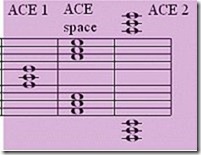I’m probably going to ruffle a few feathers here, but I think the note by note approach taken to teach music is just plain wrong. I think music concepts should be taught first as a big picture, then drilled down to build back up.
It’s like trying to climb a mountain, but the only thing you see is that it goes up and you have no idea where you should end up. You would look around this bush and that bush without any idea of where you’re headed.
You wonder around and find a trial and hope it takes you were you want to go. Problem is you end up crossing back and forth between trails.
Wouldn’t it be better if you found one trial that lead to the next to the next and got you to the top of that mountain, where you see everything?
Wouldn’t also be better if you had in your mind’s eye where you were headed, helping you keep on track?
So here’s the rub. When you start to learn, you try to learn and practice fragmented concepts in parallel.
Example of a Tough Start
 Here’s a typical example. You open a music book to learn. The first thing they give you is a simple song. In this one page you see a staff, and you have to figure out what all the parts are, but you are drawn to those big black dots.
Here’s a typical example. You open a music book to learn. The first thing they give you is a simple song. In this one page you see a staff, and you have to figure out what all the parts are, but you are drawn to those big black dots.
They have stems on them, and lines separate groups of them. There are numbers and signs, lines and spaces.
That’s a lot to take in to start. You end up trying to learn all these things at once and your poor brain gets a little overwhelmed. So if you were inspired to learn in a better manner would that help you with your knowledge and skill?
I submit it will. So let’s take a look at an idea that just might help.
Music Principles
One of the biggest hurdles in learning music or playing music is getting the basic music principles down. These principles referred to as the “dreaded” music theory.
I don’t necessarily like using the work “theory”, because it’s not really a theory that you are learning. You’re using a set of principals and rules to establish a language, or it might be call a framework that you use to learn how to use this language.
Frankly, it’s not a lot different than learning a language.
The Language of Music
These principles make up a music framework consisting of notes, rhythm, key signatures, scales, chords and those ever elusive dynamics.
Notes are like the alphabet, you learn the letters before you spell words.
Scales are like consonants and vowels; they make groups of notes more accessible to our brains.
Chords are like words, they provide a method of telling a story. And groups of chords and note runs are like sentences and paragraphs.
 Rhythm is like the pace of a story and is, of course, related to dynamics, which bring your story alive. You don’t go around shouting all the time now do you?
Rhythm is like the pace of a story and is, of course, related to dynamics, which bring your story alive. You don’t go around shouting all the time now do you?
Teaching Music Approach
The point I’ve been trying to make here is you may want to test this idea of teaching and learning music.
With your student, or you as the student, think of where you are at in learning. Can you say I know all the notes of the master staff?
If not decide to teach or learn all the notes as your one major focus for the next few weeks. Sure keep going with whatever else you are working on, but make this one item a top focus, create a path to get it learned within the studio and home.
 My thoughts would be to teach groups of notes, by putting them individually on flash cards. I might just focus on one octave at a time or maybe all the Cs, As, and Es, then pick another group the next time.
My thoughts would be to teach groups of notes, by putting them individually on flash cards. I might just focus on one octave at a time or maybe all the Cs, As, and Es, then pick another group the next time.
Maybe you take this approach with the scales earlier in the process. Devise a way to review the principals then make the homework to fill out a sheet with all the scales. Then every time you start a new song you can pull out the scale sheet and review the notes and scale that will be used in that song.
Get the big picture in first and then use it to push your efforts forward. Give it a try, see if you can get better progress with your music study.